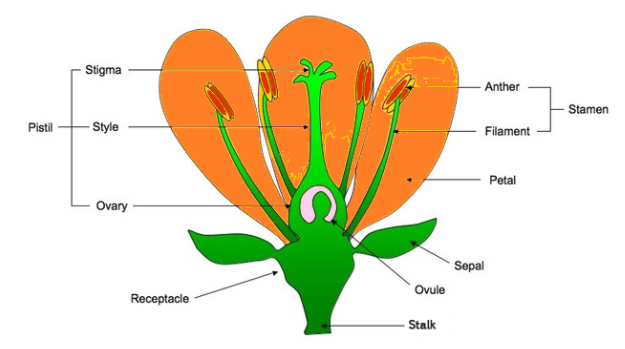
The anther and filament are parts of the
A.Pistil
B.Receptacle
C.Petal
D.Stamen
Answer
515.4k+ views
Hint: The flower contains male and female reproductive parts. Both anther and filaments are the male parts of the flower. The male contribution broadly known as pollen is produced in the anther part and develops seeds in the ovary.
Complete answer

The stamen is the male reproductive organ of a flower that produces pollen. The stamen consists of two parts: anther and filament. The pistil is the female reproductive organ of a flower and is composed of stigma, style, and ovule. So, the correct answer is the stamen.
Additional infromation:The flowers which contain either only the pistil or only the stamens are called unisexual flower flowers, e.g. Corn, papaya, and cucumber. The flowers which contain both stamens and pistil are called bisexual flowers as mustard, rose, and petunia.
The anther contains pollen grains that produce male gametes. A pistil consists of stigma, style, and ovary. The ovary contains one or more ovules. The female gamete or the egg is formed in an ovule. In sexual reproduction a male and a female gamete fuse to form a zygote.
Note:The transfer of pollen from the anther to the stigma of a flower is called pollination. There are two types of pollination: self-pollination and cross-pollination.When the pollen from the anther is accumulated on the stigma of the same or another flower on the same plant, then such pollination is called self-pollination. On the other hand, when the pollen from the anther of one flower is transferred to the stigma of another flower on a different plant of the same species, then such pollination is known as cross-pollination.
Complete answer

The stamen is the male reproductive organ of a flower that produces pollen. The stamen consists of two parts: anther and filament. The pistil is the female reproductive organ of a flower and is composed of stigma, style, and ovule. So, the correct answer is the stamen.
Additional infromation:The flowers which contain either only the pistil or only the stamens are called unisexual flower flowers, e.g. Corn, papaya, and cucumber. The flowers which contain both stamens and pistil are called bisexual flowers as mustard, rose, and petunia.
The anther contains pollen grains that produce male gametes. A pistil consists of stigma, style, and ovary. The ovary contains one or more ovules. The female gamete or the egg is formed in an ovule. In sexual reproduction a male and a female gamete fuse to form a zygote.
Note:The transfer of pollen from the anther to the stigma of a flower is called pollination. There are two types of pollination: self-pollination and cross-pollination.When the pollen from the anther is accumulated on the stigma of the same or another flower on the same plant, then such pollination is called self-pollination. On the other hand, when the pollen from the anther of one flower is transferred to the stigma of another flower on a different plant of the same species, then such pollination is known as cross-pollination.
Latest Vedantu courses for you
Grade 8 | CBSE | SCHOOL | English
Vedantu 8 CBSE Pro Course - (2025-26)
School Full course for CBSE students
₹45,300 per year
Recently Updated Pages
Master Class 12 English: Engaging Questions & Answers for Success

Master Class 12 Social Science: Engaging Questions & Answers for Success

Master Class 12 Chemistry: Engaging Questions & Answers for Success

Master Class 12 Biology: Engaging Questions & Answers for Success

Master Class 12 Physics: Engaging Questions & Answers for Success

Master Class 12 Business Studies: Engaging Questions & Answers for Success

Trending doubts
Which are the Top 10 Largest Countries of the World?

a Tabulate the differences in the characteristics of class 12 chemistry CBSE

Why is the cell called the structural and functional class 12 biology CBSE

The first general election of Lok Sabha was held in class 12 social science CBSE

Differentiate between homogeneous and heterogeneous class 12 chemistry CBSE

Derive an expression for electric potential at point class 12 physics CBSE




